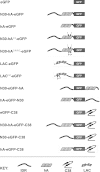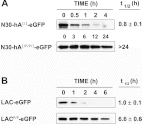Characterization of the bipartite degron that regulates ubiquitin-independent degradation of thymidylate synthase
- PMID: 23181752
- PMCID: PMC3549573
- DOI: 10.1042/BSR20120112
Characterization of the bipartite degron that regulates ubiquitin-independent degradation of thymidylate synthase
Abstract
TS (thymidylate synthase) is a key enzyme in the de novo biosynthesis of dTMP, and is indispensable for DNA replication. Previous studies have shown that intracellular degradation of the human enzyme [hTS (human thymidylate synthase)] is mediated by the 26S proteasome, and occurs in a ubiquitin-independent manner. Degradation of hTS is governed by a degron that is located at the polypeptide's N-terminus that is capable of promoting the destabilization of heterologous proteins to which it is attached. The hTS degron is bipartite, consisting of two subdomains: an IDR (intrinsically disordered region) that is highly divergent among mammalian species, followed by a conserved amphipathic α-helix (designated hA). In the present report, we have characterized the structure and function of the hTS degron in more detail. We have conducted a bioinformatic analysis of interspecies sequence variation exhibited by the IDR, and find that its hypervariability is not due to diversifying (or positive) selection; rather, it has been subjected to purifying (or negative) selection, although the intensity of such selection is relaxed or weakened compared with that exerted on the rest of the molecule. In addition, we have verified that both subdomains of the hTS degron are required for full activity. Furthermore, their co-operation does not necessitate that they are juxtaposed, but is maintained when they are physically separated. Finally, we have identified a 'cryptic' degron at the C-terminus of hTS, which is activated by the N-terminal degron and appears to function only under certain circumstances; its role in TS metabolism is not known.
Figures








Similar articles
-
Functional dissection of the N-terminal degron of human thymidylate synthase.Biochem J. 2010 Nov 15;432(1):217-26. doi: 10.1042/BJ20101027. Biochem J. 2010. PMID: 20815815
-
Cooperation between an intrinsically disordered region and a helical segment is required for ubiquitin-independent degradation by the proteasome.J Biol Chem. 2011 Oct 21;286(42):36559-67. doi: 10.1074/jbc.M111.274258. Epub 2011 Aug 30. J Biol Chem. 2011. PMID: 21878626 Free PMC article.
-
The intrinsically disordered N-terminal domain of thymidylate synthase targets the enzyme to the ubiquitin-independent proteasomal degradation pathway.J Biol Chem. 2009 Nov 13;284(46):31597-607. doi: 10.1074/jbc.M109.038455. Epub 2009 Sep 21. J Biol Chem. 2009. PMID: 19797058 Free PMC article.
-
Ubiquitin-independent proteasomal degradation.Biochim Biophys Acta. 2014 Jan;1843(1):216-21. doi: 10.1016/j.bbamcr.2013.05.008. Epub 2013 May 14. Biochim Biophys Acta. 2014. PMID: 23684952 Free PMC article. Review.
-
Effects of ligand binding and conformational switching on intracellular stability of human thymidylate synthase.Biochim Biophys Acta. 2004 Jan 14;1696(1):15-22. doi: 10.1016/j.bbapap.2003.09.005. Biochim Biophys Acta. 2004. PMID: 14726200 Review.
Cited by
-
Digested disorder: Quarterly intrinsic disorder digest (January/February/March, 2013).Intrinsically Disord Proteins. 2013 Apr 1;1(1):e25496. doi: 10.4161/idp.25496. eCollection 2013 Jan-Dec. Intrinsically Disord Proteins. 2013. PMID: 28516015 Free PMC article. Review.
-
CHIP E3 ligase mediates proteasomal degradation of the proliferation regulatory protein ALDH1L1 during the transition of NIH3T3 fibroblasts from G0/G1 to S-phase.PLoS One. 2018 Jul 6;13(7):e0199699. doi: 10.1371/journal.pone.0199699. eCollection 2018. PLoS One. 2018. PMID: 29979702 Free PMC article.
References
-
- Berger F. G., Berger S. H. Thymidylate synthase as a chemotherapeutic drug target: where are we after fifty years? Cancer Biol. Ther. 2006;5:1238–1241. - PubMed
-
- Carreras C. W., Santi D. V. The catalytic mechanism and structure of thymidylate synthase. Annu. Rev. Biochem. 1995;64:721–762. - PubMed
-
- Hardy L. W., Finer-Moore J. S., Montfort W. R., Jones M. O., Santi D. V., Stroud R. M. Atomic structure of thymidylate synthase: target for rational drug design. Science. 1987;235:448–455. - PubMed
-
- Phan J., Steadman D. J., Koli S., Ding W. C., Minor W., Dunlap R. B., Berger S. H., Lebioda L. Structure of human thymidylate synthase suggests advantages of chemotherapy with noncompetitive inhibitors. J. Biol. Chem. 2001;276:14170–14177. - PubMed
-
- Schiffer C. A., Clifton I. J., Davisson V. J., Santi D. V., Stroud R. M. Crystal structure of human thymidylate synthase: a structural mechanism for guiding substrates into the active site. Biochemistry. 1995;34:16279–16287. - PubMed
Publication types
MeSH terms
Substances
Grants and funding
LinkOut - more resources
Full Text Sources
Other Literature Sources

